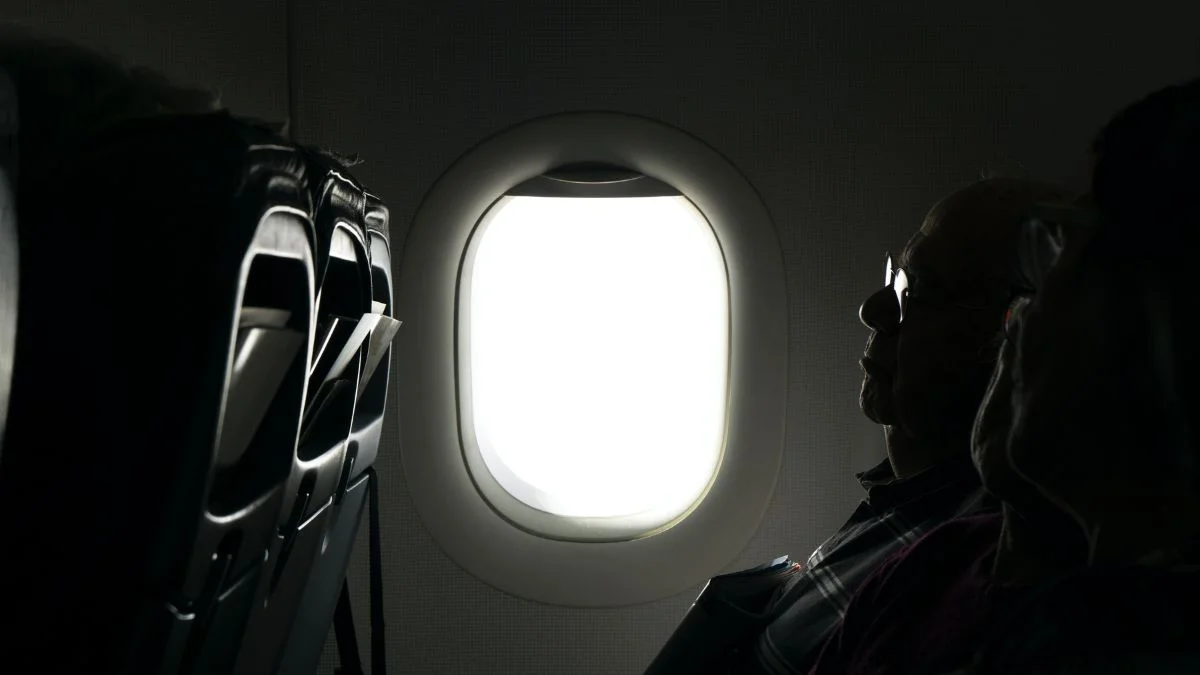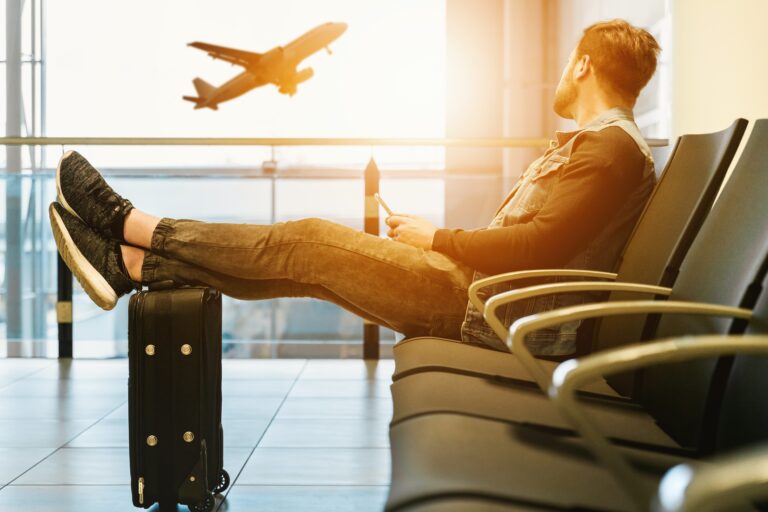How to Make a Bed on a Plane? Tips for Creating Comfort in the Sky

As participants in Amazon Associates and other programs, we earn from qualifying purchases. This comes at no additional cost to you. For more details, see our Affiliate Disclosure.
The hustle and bustle of air travel can often leave one craving for the cozy comfort of their own bed. However, with ever-evolving flight experiences, the dream of creating a comfortable, sleep-friendly zone right in your airplane seat is no longer a lofty aspiration, but a reality within reach.
This article delves into the realm of soaring comfort, outlining practical strategies to transform your cabin seat into a restful retreat. So fasten your seatbelts, as we embark on a journey to learn how to make a bed on a plane: your ultimate guide to creating comfort in the sky.
The Importance of Comfort on Long Flights
Air travel, especially over long distances, can be an exhausting experience. The lack of space, dry cabin air, and the hum of the airplane engines can make it difficult to relax or sleep, which can result in arriving at your destination feeling tired, jet-lagged, and out of sorts. However, being comfortable on a long flight is not just a matter of luxury—it’s a health issue too.
Being cramped in an airplane seat for an extended period can lead to poor circulation and a risk of deep vein thrombosis (DVT), a serious condition where blood clots form in the deep veins of your body, usually in the legs. Prolonged immobility can also cause stiffness and discomfort in your muscles and joints. Additionally, the stress of a long flight can have a negative impact on your mental health, leading to anxiety, stress, and other mental health issues.
Ensuring comfort during air travel can significantly reduce these risks, making your journey not only more enjoyable but also safer. By creating a comfortable space for yourself, you can sleep or rest effectively, which can make a big difference in your energy levels and overall well-being during and after the flight.
Comfort on a long flight can enhance your overall travel experience too. A good rest can lead to better mood and mental clarity, enabling you to fully enjoy your destination right from the moment you land. Not to mention, making your airplane seat into a comfortable bed can make the journey itself a more pleasant part of your travel adventure.
Therefore, knowing how to make a bed on a plane can be an essential skill for frequent flyers and occasional travelers alike. It can transform your long-haul flight from a necessary ordeal into an enjoyable and restful experience.
Choosing the Right Seat: Pros and Cons of Different Options
Selecting the right airplane seat can greatly influence your comfort during the flight, especially on long-haul trips. While each option has its own set of advantages and drawbacks, understanding these can help you make a more informed choice.
Window Seats
Pros:
- You can lean against the window for extra support while sleeping.
- No disturbance from aisle traffic or service carts.
- Spectacular views during takeoff, flight, and landing.
Cons:
- Limited mobility as you’ll need to ask others to move if you want to get out.
- Can be slightly cooler due to being next to the airplane’s exterior.
Aisle Seats
Pros:
- Easier access to lavatories and the ability to stretch or move around without disturbing others.
- Quick exit and entry during boarding and deboarding.
Cons:
- Potential disturbance from passengers moving around or service carts.
- Less privacy for sleep, as people walking by can easily see you.
Middle Seats
Pros:
- Might have extra legroom if flanked by armrests that don’t house tray tables.
- A compromise between the window and aisle seat advantages.
Cons:
- Can feel cramped with people on both sides.
- No direct access to either the aisle or window.
Bulkhead Seats
Pros:
- Extra legroom as there are no seats in front.
- No one reclining their seat into your space.
Cons:
- Tray tables and personal TV screens are typically in the armrest, which can reduce seat width.
- Lack of under-seat storage for personal items during takeoff and landing.
Exit Row Seats
Pros:
- Significant extra legroom.
- Can be one of the first to deboard due to proximity to the exit.
Cons:
- Responsibility during emergency situations.
- Age and health restrictions may apply.
- Limited recline capability to ensure clear access to the exit.
Business and First-Class Seats
Pros:
- Fully or partially reclining seats for optimum comfort.
- High-quality amenities and dedicated service.Greater privacy.
Cons:
- Can be significantly more expensive.
- Not available on all flights or aircraft.
By considering these factors and assessing your personal preferences and needs, you can choose a seat that will best serve you on your journey, making the process of creating your bed in the sky easier and more effective.
Packing Essentials: What to Bring for a Comfortable Flight
Packing for air travel is an art, and ensuring you have essentials to maintain comfort during the flight is crucial. Here are some items that can dramatically enhance your flying experience:
- Travel Pillow: A good travel pillow is a must-have for sleep on a plane. Memory foam options are popular, as they offer good support and can be compressed to fit into your carry-on.
- Blanket and/or Scarf: Airplanes can often be quite chilly. Having a compact travel blanket or a large scarf can keep you warm, and can also be used as additional cushioning if needed.
- Earplugs and Eye Mask: An eye mask can block out the cabin’s ambient light and an earplug can muffle the noise of the engines and fellow passengers, aiding in a more peaceful sleep.
- Noise-Canceling Headphones: If you’re sensitive to noise or are easily distracted, investing in a pair of noise-canceling headphones can be beneficial.
- Compression Socks: These can help prevent swelling and reduce the risk of DVT (Deep Vein Thrombosis) on long flights.
- Hydration Essentials: The dry cabin air can cause dehydration. Carry a refillable water bottle to stay hydrated, and don’t forget a good quality moisturizer and lip balm.
- Portable Charger: Ensure your devices are always ready to use, as watching a movie or listening to music can be a good way to relax during the flight.
- Comfortable Clothing: Pack a change of loose and comfortable clothing. Layered outfits allow you to adjust to changing cabin temperatures.
- Snacks: Airplane food might not always cater to your taste or dietary needs. Having your favorite snacks can be a comfort and ensure you’re not going hungry.
- Sanitation Essentials: Travel-size hand sanitizers, antibacterial wipes, and a face mask are important for maintaining hygiene and feeling fresh during your flight.
These are just a few of the essentials you can pack to ensure a more comfortable flight. Customize your comfort kit to suit your personal needs and preferences.
Setting Up Your Space: Tips for Maximizing Comfort
Setting up your airplane seat to maximize comfort involves a few strategic steps. Here’s how you can transform your cabin seat into a cozy nook:
- Clean Your Surroundings: As a first step, wipe down your seat, armrests, tray table, and other surrounding surfaces with antibacterial wipes. This not only ensures hygiene but also helps in creating a fresher environment.
- Arrange Your Essentials: Have your travel pillow, blanket, eye mask, headphones, water bottle, and any other items you’ll need during the flight within easy reach. This reduces the need to rummage through your bag mid-flight and disturb your setup.
- Recline Your Seat Properly: Most seats, except for those in front of an exit row or at the very back, can be reclined to provide a more comfortable position for resting or sleeping. However, be mindful of the person behind you while reclining.
- Make Use of Blankets and Pillows: Use airline-provided or personal travel pillows and blankets to create a comfortable arrangement. Pillows can support your lower back or neck, while blankets can provide warmth.
- Take Off Shoes: Remove your shoes to relieve your feet, but consider wearing compression socks or airplane slippers to keep your feet warm and clean.
- Adjust the Lighting: Make use of the personal overhead light for reading. If you’re trying to sleep, turn off this light and use an eye mask to block cabin light.
- Manage Air Vent: Adjust the overhead air vent to ensure you have enough ventilation. A direct blast can be too cold, so aim it above your head.
- Use Technology: If you’re planning to watch movies or listen to music, make sure your devices are accessible and charged. Noise-canceling headphones can block out ambient noise.
- Stay Hydrated: Keep a water bottle handy and take regular sips. This can help combat the dry cabin air.
- Consider Seat Position: If in a window seat, you can lean against the wall after placing a pillow for extra cushioning. If in an aisle seat, lean in the opposite direction or use your travel pillow for neck support.
By making a few adjustments and using travel accessories wisely, you can create a comfortable space to rest or sleep during your flight.
Sleeping Positions: Finding the Best Position for You
Finding the best sleeping position on an airplane can be a bit of a challenge due to space constraints and seat design. However, there are a few positions that can maximize comfort and help you get some rest during your flight.
- Reclined Position: This is the simplest and most common sleeping position. Recline your seat as far as it will go, use a travel pillow to support your neck, and drape a blanket over yourself for warmth.
- Side Lean: If you have a window seat, you can use a pillow against the wall of the plane to create a comfortable surface to lean against. Make sure to use a blanket to cushion any hard parts of the plane you may come in contact with.
- Forward Fold: Tray tables can double up as a makeshift rest. First, place a pillow or blanket on the tray table, then fold forward onto the pillow. This position, though not always the most comfortable, can be helpful when the seat recline is minimal.
- Empty Row Stretch-Out: If you’re lucky enough to find yourself on a less crowded flight with an empty row of seats, take advantage. Raise the armrests and lay across the row of seats, using a pillow to support your head.
- Aisle Armrest Lean: If you’re in an aisle seat, lower the armrest and lean towards it, using a pillow or blanket for cushioning.
- Seated Upright: If reclining isn’t an option, a good travel pillow can provide the necessary support to sleep while sitting upright.
- Business or First-Class Lay Flat: If you’re in business or first class, your seat may convert into a fully flat bed, which is obviously the best option for sleeping on a plane.
Your comfort depends on the seat you have and your personal sleep preferences. Don’t forget to fasten your seatbelt over your blanket or clothing so flight attendants can see it’s fastened and won’t have to wake you. Experiment with these positions to find the one that works best for you.
Top 5 Travel Pillows
In the quest for comfort during long-haul flights, a reliable travel pillow emerges as an invaluable asset. With the power to make or break your in-flight sleep experience, choosing the right one is of utmost importance. Whether you’re an aisle person, a window enthusiast, or stuck in the middle, there’s a pillow designed to cater to your specific needs. Here, we’ve curated a list of the top 5 travel pillows, each offering a unique blend of support, comfort, and portability.
Cabeau Evolution S3 Travel Pillow
Deftly combining comfort with innovation, the Cabeau Evolution S3 Travel Pillow is a standout in the world of travel accessories. Constructed from high-quality memory foam, this pillow conforms to the contours of your neck, providing soft yet firm support that helps to prevent stiffness and discomfort.
What sets the Evolution S3 apart is its Seat Strap System, which attaches to the airplane seat wings, ensuring your head stays upright and preventing any forward drop. This feature also guarantees that your pillow stays in place, even when you shift positions. This, coupled with its adjustable clasp and moisture-wicking cover, makes the Cabeau Evolution S3 a go-to choice for many frequent flyers.
Trtl Pillow
The Trtl Pillow has revolutionized the travel pillow market with its unique and scientifically proven design. Unlike traditional travel pillows, the Trtl Pillow is more of a wrap than a pillow, equipped with an internal support system that cradles the neck and keeps the head in a comfortable position.
Its small, lightweight design makes it easy to pack, and the soft fleece material provides a cozy feel. Perfect for those who prefer to pack light, the Trtl Pillow delivers the right balance of comfort, support, and convenience, making those long-haul flights considerably more bearable.
BCOZZY Chin Supporting Travel Pillow
Offering 360-degree support, the BCOZZY Chin Supporting Travel Pillow is specifically designed to prevent your head from falling forward or sideways while you sleep. Its unique wrap-around shape can be adjusted to fit your neck perfectly, ensuring personalized comfort.
Whether you lean your head to the side or let it drop forward, the BCOZZY pillow is there to provide cushioned support. The added chin rest contributes to its distinct design, making it a great choice for those looking for all-around neck and chin support during their travels.
Travelrest Ultimate Travel Pillow
For side sleepers, the Travelrest Ultimate Travel Pillow is a game changer. Its innovative, inflatable design provides full lateral support, making it an excellent choice for those who prefer to lean to one side while sleeping. It’s also versatile, allowing you to wear it like a messenger bag or tether it to the plane seat for added stability.
The Travelrest pillow’s ergonomic design promotes proper head, neck, and cervical alignment, even in the compact space of an airplane seat. In addition, when deflated, it rolls up neatly, making it easy to pack and carry.
Tempur-Pedic Travel Neck Pillow
Renowned for their pressure-relieving mattresses, Tempur-Pedic brings the same level of luxury and comfort to their travel neck pillow. Constructed with their proprietary TEMPUR material, this pillow conforms to the shape of your neck and shoulders, providing personalized support that helps to maintain a neutral spinal alignment. It’s also covered with a plush, removable, and washable cover for added convenience.
Despite being slightly bulkier than other travel pillows, the Tempur-Pedic Travel Neck Pillow scores high on comfort, making it worth the extra packing space. Its enduring support and plush feel can turn your in-flight sleep from a challenge into a delight.






